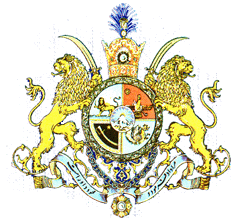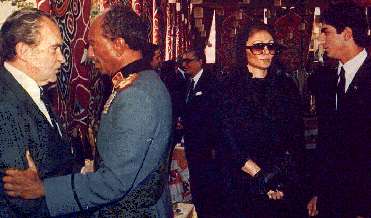

Exile
On January 16, 1979, the Shah and the Empress left Iran for an exile which was thought to be only temporary. At a strike-ridden and empty airport, in presence of only a restricted group of loyalists and Prime Minister Bakhtiar, the sovereigns left by plane for Assouan in Egypt. The Shah could hardly keep his tears. The Queen had taken tranquilizers to hide her deep sadness. President Sadat and his family welcomed them with profound friendship. It was the beginning a painful and long wandering which would take them in succession to Morocco, the Bahamas, Mexico, the United States, then Panama and finally Cairo.
On February 11, 1979, Khomeyni took power and a death warrant against the Shah and his entourage was iussued. It was a condemnation which extended to all those who would give them hospitality or help them. The Shah and the Shahbanou were obliged to leave the country without a definite destination for no land of haven had been suggested. Upon the intervention of the United States, the Bahamas Islands accepted to grant them asylum for only three months, on the condition that the Shah would refrain from taking any action or make any declaration. They went later on to Mexico, where the health of the Shah who had cancer, rapidly deteriorated. An operation becoming necessary, the United States, for humanitarian reasons accepted under the condition that the surgical intervention would take place in New York. This action provoked the wrath of the Iranian authorities. They requested the prompt extradition of the sovereign and enforced they demand by taking hostage the personnel of the American embassy in Tehran. Despite urgent medical needs, the Shah and the Shahbanou were forced to leave New York for Texas, until a new country of asylum could be found.
That country was Panama, where again the Iranian government exerted considerable pressure to obtain an extradition. The Shah was in dire need of a new surgical operation, but after having accepted American surgeons to operate the Shah on its territory, Panama recanted. The United States administration dispatched two envoys to let the Shah know that should he wanted to be operated in the United States, he would have to abdicate. At that time, President Sadat asked the Shah to hurry and come to Egypt. The sovereigns departed for Cairo on March 23rd 1980. At an Azores Islands stopover, some U.S. officials held the plane under the pretext of refueling. All the while, they were negotiating with the Islamic government procedures to return the aircraft to Panama. At long last, the Shah and the Shahbanou landed on Egyptian soil where President Sadat greeted them with utmost warmth, friendship and fraternity. In Cairo, they were able to see their children who had been studying in the United States and from whom they had been separated.
The Shah passed away in Cairo's Maadi hospital on July 27, 1980. President Sadat organized official if not national funerals. The Shah's coffin, covered with the Iranian flag, was transported on a canon barrel with full military honors. In conformity to the Constitution, the Empress assumed the charge of the regency until the majority of her elder son. On October 31, 1980, the Crown Prince reaching legal majority, (20 years) swore under the holy Quran, to assume the responsibilities that the Iranian Constitution demanded from him, and thus by right became, Reza Shah II of Iran.

The King of Iran received a last hommage in the presence
of
His Host President Sadat who told the world what loyaty means.
From right to left Reza Shah II, Empress Farah, President Sadat and President
Nixon
See More Pictures and text in "Sad Time in Cairo."
Today, the Empress lives between the Unites States and France. Each year, she accomplishes a pilgrimage of remembrance at the tomb of the Shah who rests at the Al Rifai Mosque. Following seventeen long years, and after courageously facing the many difficulties that come from exile, the Empress now lives quietly, taking care of her children and family. She is rebuilding for them a new life. She keeps abreast of political events in her country as well as those of the international community. The Queen still sees heads of states, presidents and monarchs, and, at the side of her son, keeps in constant touch with her compatriots in exile. She likes to recall passages of the last work of the Shah "Answer to History." They are always present in her mind and brighten her path:
"Today, our Great Civilization may appear to have died for all time. I believe, however, that like those powerful rivers that disappear underneath the mountains, lost to view, only to emerge later in full force, Persian culture will rise to surface again, nourished by the values, creations, thought, talent, and effort of the people. From their trials will be reborn both spiritual and material victories. My thoughts have never left my country. They remain there. I think of all those compatriots who, under the reign of my father and myself, pulled Iran out of darkness and servitude and transformed it in to the great nation it was in 1978... Today, away from my country, I pray for those in the agony of poverty and death. I pray for our youth deceived and misguided. I pray for those who suffer in silence. I pray for those who are hunted and slandered. I pray for those who remain blind to falsehood and deceit. May God enlighten them and remove the hate forever from their hearts. O God Almighty, in Whom I believed all my life, preserve our country and save our people." (Answer to History, 1979)
Heartened by the thoughts of her husband, the Empress keeps faith and is convinced that Iran will be reborn from its ashes and that light will finally prevail over darkness.